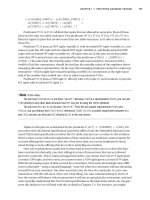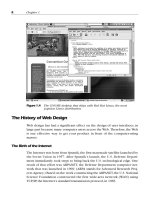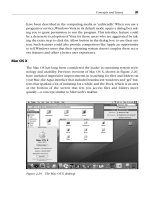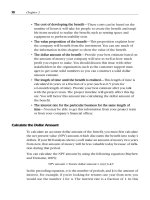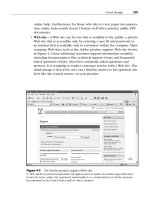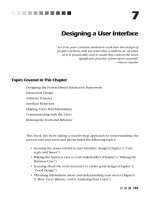User Interface Design for Mere Mortals PHẦN 6 pptx
Bạn đang xem bản rút gọn của tài liệu. Xem và tải ngay bản đầy đủ của tài liệu tại đây (9.75 MB, 31 trang )
Summary
This chapter began with a discussion about the psychology of user actions
and user misunderstandings and misinterpretations and how and why they
happen. It also covered how personality types identified in the Myers-Briggs
Type Indicator can affect users’ actions and how those temperaments can
affect the type of questions they ask when being persuaded to do something.
Knowledge in the brain versus knowledge in the world was covered next.
You learned how most people rely on imprecise knowledge to get through a
situation. This is largely because our brains can accept only so much informa-
tion, and we break up more complex tasks into smaller ones so we can keep
track of everything. You also learned how people are reminded of knowledge
by the world, and what the trade-off is using knowledge from the brain and
from the world.
A discussion of task structures followed the topic of breaking up tasks. It
talked about the different types of task structures: wide and deep structures
that provide a large number of choices, shallow structures that offer a top-
level choice and a few subchoices, and deep and narrow structures that pro-
vide step-by-step instructions for completing a task. Our conscious and
subconscious behavior determine the type of task we use.
Next, this chapter covered transforming difficult tasks into simple ones to
allow digestion of a user interface. It discussed seven task simplification prin-
ciples that you can use in any design situation. The seventh and final principle
is the most important one: When all else fails, standardize.
The chapter included a discussion on how computer users bring a concep-
tual model with them in their brains when they approach a new user inter-
face. That conceptual model is based on the users’ past experiences, beliefs,
and ways of doing things. The chapter concluded with the step-by-step
process that users go through when they create a conceptual model.
132 Chapter 5
Review Questions
Now it’s time to review what you’ve learned in this chapter before you move
on to Chapter 6. Ask yourself the following questions, and refer to Appendix
A to double-check your answers.
1. What are affordances?
2. What are constraints?
3. Why do people consider themselves helpless when they fail at a task?
4. What does the MBTI test do?
5. What are the seven stages of human action?
6. What are the trade-offs between knowledge in the brain and in the
world?
7. What task structure is the most challenging for people?
8. Why must you be deliberate when you’re using your conscious mind?
9. Why do you transform difficult tasks into simpler ones?
10. What makes up a person’s conceptual model?
How Users Behave 133
This page intentionally left blank This page intentionally left blank
6
Analyzing Your Users
“Observation more than books, experience more
than persons, are the prime educators.”
—Amos Bronson Alcott
Topics Covered in This Chapter
The Users’ Mental Model
The Experience Bell Curve
Understanding the User’s Goals
User and Task Analysis
In Chapter 5,“How Users Behave,” you learned about how users behave as
well as the personality types, experiences, and behaviors that they bring with
them. This users’ mental model is the user vision for your user interface—
what they expect the interface will look like and how it will behave. The
closer you come to this vision in your interface design,the happier your users
will be.
If you plotted user experience levels on a graph, you would find that they
adhere to a bell curve. Most of the users on this bell curve have an intermedi-
ate level of knowledge, and you can design your user interface to meet the
needs of this large group of users.
To create a good interface or product design for your users, you need to have
goals. Therefore, this chapter discusses the Goal-Directed Design Process pro-
moted by Cooper and Reimann (2003). This process is composed of five
phases for understanding the users’ goals. You can get an idea of what you’re
looking for by answering a series of questions during the design process. You
will also learn where the Usability Engineering Life Cycle from Chapter 3,
“Making the Business Case,” fits into the Goal-Directed Design Process.
135
Users have goals,but how do you find out what those goals are based on their
situations? You do this through user and task analysis, which also fits into the
Goal-Directed Design Process. Then you can create personas of your users,
which are representations of specific types of individuals with specific needs.
After you have personas in place, you can prioritize them to determine the
personas for which you want to design your user interface.
The Users’ Mental Model
As Cooper and Reimann (2003) point out, the software development process
has gone through four phases. When computers first came about, people who
knew how to program them were hackers. Originally,programmers did every-
thing when it came to designing computers. This was also true as the first
home computers—such as the Commodore PET and 64, Atari 400 and 800,
Radio Shack TRS-80, and Apple II—became popular in the late 1970s and
early 1980s.
The advent of VisiCalc for the Apple II,and later the acceptance of the IBM PC
and compatibles in business, forced the programming industry to fall under
the rubric of business processes, where managers drove new software proj-
ects. Much of the work that the managers did involved specifying a list of fea-
tures and then watching as all the features specified for version 1 still didn’t
make it in time for version 3.
As graphical user interfaces (GUIs) became standard in the 1990s and more
people bought computers for the home to connect to the Internet, more
companies became interested in the look and feel. In part, that was because
they found that a lot of people were calling them to complain about usability
features, and they wanted to keep their customer service costs from rising.
The use of beta testers (preferred customers who test the software and iden-
tify bugs before general use) as well as usability testing became common dur-
ing this period.
In the past 5 to 10 years, the issue of good design prior to the coding period
has been gathering steam. Unfortunately,despite the introduction of design in
the software development process, most engineers still design software from
the point of view of adding features and functionality, because the functional-
ity is what’s important to engineers. As a result, many software programs
either clumsily implement or don’t implement digital-age improvements to
mechanical-age structures.
136 Chapter 6
Take the calendar as an example. Early Windows programs simply showed the
calendar one month at a time and didn’t provide any other functionality, such
as the ability to scroll month by month or even year by year. My calendar in
Outlook 2003 is better, as you can see in Figure 6.1, but it’s still functionally
limited. For example, for the next three months, I can see the calendar sum-
mary in the upper-left corner of the Outlook window, but I can’t see a yearly
calendar in Outlook. I can view only one month at a time.
The point is that software engineers are still building to mechanical-age stan-
dards. They’re only slowly building in technologies that help extend the func-
tionality of familiar systems such as the calendar.
Analyzing Your Users 137
Figure 6.1The calendar in Outlook 2003.
138 Chapter 6
The Result
The result of this mechanical-age design is that you have four primary bad
behaviors that still haven’t been fixed (Cooper and Reimann, 2003):
•
Software makes assumptions about the user’s ability to understand
why something needs to be done
—If the program doesn’t tell you why
something is being done, you could make a mistake that could cause
you to lose a lot of work. For example, if you presume that the software
saves your work before you close it, and you decides not to save the file
when prompted because you think the file is saved automatically, you’ll
get a rude surprise when you try to open it.
•
Software is of
ten rude to the user; it blames the user for problems that
are instead the fault of
f poor design
—How many times have you
received an error message that doesn’t tell you anything about why the
problem occurred? (See the one in Figure 6.2, which asks for installa-
tion media even though it’s installed.)
•
Software is obscure
—Many of the error messages that you find in Win-
dows are obscure and don’t provide information about how to fix the
problem. The only “improvement” in this regard that Microsoft has
implemented is to include a list of programming codes that show
where the problem is, ostensibly to help the technical support people
determine what’s causing the problem. (Few users take the time to
contact technical support.) This information is largely useless to any-
one but the developers (and perhaps even to them), but that’s not
entirely the case. With some error messages, you can look up the error
code on the Web and see if there is any information about the problem
associated with the code. Hopefully, you’ll find suggested solutions to
the problem as well.
Figure 6.2Software behavingbadly.
•
Software behavior can be baffling
—For example, when I check the
word count in a document in Microsoft Word, which is a task that does-
n’t change anything in the document,Word asks me to save the file
again. This behavior hasn’t changed in subsequent new versions of
Office. WordPerfect, however, closes the program without asking me to
save it.
Implementation Versus Mental Models
Cooper and Reimann (2003) differentiate between the implementation
model and the users’ mental model:
•
Implementation model
—The representation of how a product actually
works.
•
Users’ mental model
—Stipulates that users don’t need to know all the
details about how something works to use it. For example, you don’t
need to know how your CD-ROM drive burns data onto the CD—all
you need to know is how to put the disc into the drive properly so that
the computer will write the data to the disc (and not use the CD-ROM
drive as a cup holder).
Unfortunately, most software designed by engineers follows the implementa-
tion model because the interface conforms to the logic within the software.
For example, a separate dialog box represents every user action (Cooper and
Reimann, 2003), and the user is prompted for information when the program
needs to receive it instead of when it’s natural for the user to provide that
information.
Because people form mental models that are simpler than reality, designers
should always strive for simplicity—one of Norman’s (2002) principles
for transforming difficult tasks into simpler ones. (You may have heard of the
acronym KISS, which means Keep It Simple, Stupid.) Users don’t care about
how something works, and they don’t care if their perceptions are accurate
or even true. They understand what they interact with, and they expect the
interface to reflect their own model as much as possible. The closer that
the implementation model is to the mental model, the easier the interface for
the user.
Analyzing Your Users 139
140 Chapter 6
The Experience Bell Curve
Chapter 5 discussed the experiences, behaviors, and other personality traits
that people bring with them, and the previous section discussed how the
users create a mental model from all these components. If you polled several
different groups of users and plotted their experience levels on a chart, you’d
find that most of them fall into the range that Cooper and Reimann (2003)
describe as perpetual intermediates. Cooper and Reimann call intermediate
users perpetual because most of them have neither the time nor the interest
to learn more about the program than they need to know to complete their
regular tasks in a timely manner.
The chart would look like a bell curve, as shown in Figure 6.3, with the bulk
of the curve being populated with perpetual intermediates, and beginners
and advanced users on either end.
The bell curve is not an accurate representation of every computer user for
every user interface through all time. People who are beginners don’t stay
that way for long,in part because people don’t like to feel incompetent. Also,
users are likely interested in learning how to use the interface because it will
benefit them. People can also transition from the intermediate to the
advanced stage if they use enough features for a certain period.
The curve can also be skewed depending on how you define experience. For
example, if you have a large number of people using a program for the first
time, the curve will be skewed so that most of the people using the program
Beginners Intermediates Advanced
Figure 6.3 The experience bell curve.
are beginners, and a much smaller group in the graph (usually the developers)
are in the intermediate to advanced stage. However, if all the users in the test
are proficient in Windows, the chart can skew the other way to show that
there are no Windows beginners in the group—just intermediates and
advanced users at different stages of knowledge.
Different Needs for Different Groups
The three groups of users—beginners, intermediates, and advanced—have
different needs (Cooper and Reimann,2003). If you design your user interface
(as well as peripheral information such as your documentation) to meet these
needs, all these groups will be more satisfied than if you design primarily for
one group or the other.
Beginners
Beginners know they’re novices when they start using a program, and they
don’t want the program to reinforce that feeling. Users want to be treated as
intelligent people, and they want to learn as quickly as possible. Therefore,
instruction needs to be delivered quickly and effectively. This is a good reason
to design your user interface as closely to your users’ mental models as possi-
ble.You’ll learn how to analyze your users’mental models later in this chapter.
Beginners have questions that are more basic and broad:
• What does this product do?
• Where do I begin?
• What do I need to do to complete the tasks?
Some pieces of software simply refer to online help as their only means of
support, but online help is not designed to be a tool for getting beginners up
to speed. If online help is designed well, it is for intermediates and experts to
get quick information about a question or issue. A better method for getting
beginners up to speed is a demonstration that shows them basic tasks and
how to use the program to complete those tasks. This demonstration should
be interactive whenever possible so that the tutorial can reinforce the steps
needed to complete a task. There are programs that provide interactive tuto-
rials. You can even design an interactive design tutorial in PowerPoint if you
want (see Figure 6.4).
Analyzing Your Users 141
142 Chapter 6
Intermediates
Intermediates are looking for specific answers to questions, including these:
• Can you remind me how to perform this task?
• How do I find this function?
• What new features are in this upgrade?
• Can I undo my last action?
• What’s the command to perform this task?
These users want access to the tools they need to use, so it’s important to
design your user interface to get them those tools right away.You can do a lot
of this in the user interface. Intermediate users depend on online help that’s
easily accessible from within the program and provides answers quickly.
Figure 6.4 A sample interactive PowerPoint tutorial.
Intermediates don’t need to know about advanced features, but they like to
know they’re there in case they need them at some point in the future. How-
ever, many intermediates are assured by having the Microsoft Word advanced
features there in case they ever need to use them in the future.
Advanced Users
Advanced users use the user interface constantly, so they develop an instinc-
tive feel for its nuances after a certain period. Therefore, their questions are
about connecting their actions to the program behaviors:
• Are there shortcuts for completing this task?
• Can I automate this task?
• How can I customize the interface for my needs?
Some experts are also looking for specific information about a feature of the
program that they use regularly but most people don’t use, such as the equa-
tion editor in Microsoft Word (as shown in Figure 6.5) or Adobe FrameMaker.
Analyzing Your Users 143
Figure 6.5 Word’s equation editor.
Understanding the User’s Goals
The Internet has changed the way people think about interfaces and the way
companies market to users (Eisenberg and Eisenberg, 2006). This is both
a problem and an opportunity for user interface designers. The problem
is that users are now driving not only the marketing of products, but also
the user interface design. The opportunity is that the designer(s) can get a
better grasp of the disconnections between the users’ goals and the user
interface design.
Cooper and Reimann (2003) identified the problem as being a disconnection
between research performed by market analysts and the design of the inter-
face performed by designers. To fill in the gaps, Cooper and Reimann created
the Goal-Directed Design Process for software engineering and user interface
design. These gaps are in the forms of three new primary activities between
the research and refinement stages.
The entire five-step Goal-Directed Design Process combines ethnography (a
method of studying and learning about a person or group of people),
research, modeling, and design into five phases, in the following order
(Cooper and Reimann, 2003):
1.
Research
—This phase uses observational and contextual testing as well
as interviews to learn more about potential and actual users of the
product. One of the primary outcomes of research is the discovery of
usage patterns, which suggest the goals and motivations for using the
product. For example, if you do research on word processors, one moti-
vation is to write and edit documents more quickly than doing so by
hand. You will learn more about observational and contextual testing in
Chapter 9,“Usability.”
2.
Modeling
—After the research is completed, the modeling phase ana-
lyzes the research for user and workflow patterns, and from that creates
user models based on those patterns. Those models are based on group-
ings of user goals, motivations, and behavioral patterns. From these user
models, or personas, the project team determines how much influence
each persona will have on the interface design. You’ll learn more about
personas in the next section.
3.
Requirements
—In this phase, the project team creates requirements
that meet the needs of one or more of the personas you identified in
the modeling phase. To meet the requirements, you need to learn more
about the user in the environment in which he would be using the
interface. That takes user and task analysis, which you’ll learn about
later in this chapter. The result of this phase is a requirements defini-
tion that balances the needs of the user, the business,and the technical
necessities.
4.
Framework
—Designers create an interaction framework that produces
a structure for the program so they can add the remainder of the code
later. This framework melds general interaction design principles with
interaction design patterns to create a flow and behavior for the prod-
uct. Parts of the framework include input methods, views, data ele-
ments, functional elements and groups, and group hierarchy. You’ll learn
more about creating an interaction framework in Chapters 7,“Design-
ing a User Interface,”and 8,“Designing a Web Site.”
144 Chapter 6
5.
Refinement
—This phase refines the framework and includes detailed
documentation of the design as well as a form and behavior specifica-
tion. This phase defines what the design should do to meet the goals of
each persona identified in the Modeling phase as well as the business
that employs the persona. For example, you should identify a problem
that both the persona and business are having, such as having inade-
quate tools to gain customer feedback, and then identify the solution
that your interface will provide to the persona and the business.
The Goal-Directed Design Process also includes important questions that
project teams should ask during the process (Cooper and Reimann, 2003):
• How do I find out who my users are?
• How do I learn what my users are trying to accomplish?
• How should my product behave?
• What form should my product take? For example, should the product
be GUI-based or Web-based?
• How will users interact with my product?
• How can my product’s functions be most effectively organized?
• How will my product introduce itself to first-time users? In other
words, how will first-time users know where to start?
• How can my product put an understandable and controllable face on
technology?
• How can my product deal with user problems?
• How will my product help infrequent users become more expert?
• How can my product provide sufficient depth for expert users? For
example, how can I automate things so that expert users can become
more productive?
Analyzing Your Users 145
Note
In this list, the use of the word product doesn’t just include your user
interface; it also includes all contact with the user through the program,
including error messages and online help. You will only be able to answer
all these questions effectively if you take into account all the messages
that your interface sends your user.
146 Chapter 6
The Goal-Directed Design Process was designed to keep everyone in the
loop, keep guesswork out of the design process, and provide a clear rationale
for decisions. Note that this process is not linear. You will likely go back and
forth between different phases as required to obtain as much information as
possible to create an effective user interface.
If you’re on a product project team, it may adhere to this or a similar process.
You should not only be aware of this process, which is similar to discovering
information from users and refining documentation, but you should also
strive to dovetail all related efforts, such as documentation and training, with
this process. Dovetailing your efforts will ensure not only that all on the team
understand the process, but also that they perform some joint research to
gather information and give you an opportunity on the product’s interactive
processes.
User and Task Analysis
The users’ mental model is based on many factors, including their experi-
ences, behaviors, beliefs, and situations. As you analyze your users’ mental
models, what you’re really doing is marketing to them. As mentioned in the
previous section,users are now driving the marketing and acceptance of user
interfaces, so it behooves you to make every effort to find out what users are
thinking about.
The Research phase of the Goal-Oriented Design Process involves research-
ing how users behave in a number of ways using qualitative and quantitative
research (Cooper and Reimann, 2003). Quantitative research is the most
objective type of information, but there are numerous ways to interpret sta-
tistics to fit a certain point of view. In addition, quantitative research can’t
capture the complex interactions between a human being and a user inter-
face.
Qualitative research is research based on the characteristics of something
rather than a number or measurement. This book has been building up to this
point by discussing the questions you need to ask as well as the different user
types. To answer these questions and learn what sorts of users you have, you
need to employ qualitative research techniques. These techniques include
the following (Cooper and Reimann, 2003):
Analyzing Your Users 147
• Reviews of competing products.
• Reviews of market research, such as computing media Web sites and
technology white papers.
• Researching market demographics in the area you’re developing in.
That research can include analyzing demographic, geographic, or
behavioral variables to see if any patterns emerge.
• Interviews with stakeholders (such as the sales and marketing depart-
ment), developers, subject matter experts (SMEs), and other experts as
needed.
• Ethnographic interviews, in which one or more members of the proj-
ect team interview a group of users. This group is based on a hypothe-
sis about what the team wants to get out of an interview, such as
learning what needs users have.
• Conducting focus groups in a room and asking the groups to answer a
structured set of questions or make certain choices.
• Engaging in usability and user testing. The most effective means of user
interface testing is user and task analysis, which is done by observing
the user as he works in his natural environment. That environment is
usually the workplace, but it is more than just the user’s cubicle or
office—it’s about the user’s work day and how he employs the tasks
every day.
Constructing Personas
Part of user and task analysis is constructing personas, which is also part of
the modeling phase of the Goal-Directed Design Process. Before you engage
in user and task analysis, you need to learn who your users are by construct-
ing personas. As you read at the beginning of this chapter, personas are user
models based on groupings of different user characteristics.
Eisenberg and Eisenberg (2006) discuss the creation of personas in terms of
sales, which is essentially what you’re trying to do with your user interface:
persuade the user that the interface is worth using. Personas connect three
different dimensions of information into one cohesive persona:
•
Demographics
—This segments some of the persona features. For
example, demographic data shows such data as the user’s gender, loca-
tion, and income.
148 Chapter 6
•
Psychographics
—This segments some of the persona needs and deter-
mines questions that each persona may ask. For example,a sponta-
neous type and a competitive type will ask different questions and will
want different types of information.
•
Topology
—This allows you to segment by determining how complex
the persuasion process is; that complexity is based on a customer’s per-
ceptions and experiences.
Regarding the topology dimension, Eisenberg and Eisenberg mapped a four-
dimension model for the process of persuasion in sales:
•
Need
—This is the urgency that a user feels for a product or service.
•
Risk
—This is the amount of risk the user is willing to accept regarding
such features as a career or self-esteem.
•
Knowledge
—This is how much knowledge the user has about the
product, which can affect need and risk. For example, if someone feels
he doesn’t have enough information about a product or service, the
risk factor for that user is higher.
•
Consensus
—This is the understanding during the persuasion process of
how many people need to be convinced and when.
The information from the three dimensions of information—demographics,
psychographics, and topology—begins to reveal the motivations of your per-
sona types so you can learn what motivates your users to do something.
The Advantages of Personas
Personas overcome several problems that you have at the start of the user
design process (Cooper and Reimann, 2003). As you develop personas, you
communicate with developers, designers, and other stakeholders to learn
what their understanding of user needs are, which encourages more collabo-
ration. The project team uses that input to determine what a product should
do and how it should behave. Then it builds several design choices for
prospective users to test.
Learning about your users through personas helps minimize or eliminate four
design issues that can arise during product development (Cooper and
Reimann, 2003):
• The elastic user—that is, the definition of the user in the mind of the
designer, developer, or other project team member that allows the
member to design the interface and claim he is serving the user. By
identifying the typical users of the software, the project team can
design the interface to the users’ needs as shown through research, not
what’s in a particular team member’s head.
• Self-referential design involves designers or developers projecting their
ideas onto the project and claiming that this is what the user wants. In
other words, the designer or developer thinks he is a typical user.
• Designing for edge cases, meaning that the project team will design for
every eventuality that could happen but probably won’t. With a list of
personas available through research, the project team can focus on
tasks and functions that will be most important to the majority of users.
• Targeting people who are not end users. There is a tendency to target
people who review the software or people in your IT and customer
support departments who will be administering and supporting the
software. However, by knowing who your real end users are, your proj-
ect team will be able to design for those users.
The project team then measures the effectiveness of the design by testing
design choices on different personas. The feedback from those choices helps
the project team build a consensus about and a commitment to the final
design.
Personas are also useful for other product-related development efforts,
because you can apply what you learn in creating personas for one project to
other projects.
Fusing Behaviors, Characteristics, and Goals
Constructing a persona requires you to fuse the behaviors and characteristics
of your users with the goals of your users to create a narrative that explains
the persona (Cooper and Reimann, 2003).
This chapter has already discussed the project team goals as part of the Goal-
Directed Design Process, but users have their own goals and motivations.
These goals include the following:
•
Life goals
—These are met through personal motivations such as
wanting to become the president of the company or learn all there is to
know in a particular field or area of software.
Analyzing Your Users 149
150 Chapter 6
•
Experience goals
—These are met by a deep desire to feel competent
by not making mistakes, avoid feeling stupid, and enjoy oneself as
much as possible.
•
End goals for using a specific product
—These can include finding the
most “bang for the buck”when it comes to the best combination of fea-
tures and service, finishing tasks quickly and efficiently, and finishing
short-term and long-term goals such as fulfilling a customer service
request or completing development of a product.
User goals are not the only ones you have to consider when you create your
personas. You must also manage the goals of other stakeholders who are both
inside and outside your company. In addition, there are three other goals that
you have to consider in design (Cooper and Reimann, 2003):
•
Technical goals
—These goals include ensuring that the program runs
in all modern operating systems and that it is secure from viruses,
worms, and other malware. If you have a hardware product, your prod-
uct team must ensure that the hardware is reliable and performs as
expected. If your product is not reliable and secure, no one will buy it.
•
Customers’ goals
s
—Customers are different from users in that they are
not going to use the product, but they will give the product to some-
one else to use. Therefore, customers are very interested in ensuring
that the recipient is satisfied by the customer’s purchase. Customers
may also manage products but not use them regularly, such as a prod-
uct that manages a network server. In these cases,the customers are
more interested in the program’s stability and security.
•
Business g
oals
—Examples are decreasing costs and increasing profits
for the company that is developing the product. Satisfaction of busi-
ness goals can also show stakeholders that there is a return on invest-
ment (ROI) for user interface design and usability testing, which can
ensure that such techniques are valid and should be used with other
projects,
These goals should never supersede the users’ goals, but in the case of the
customer goals, they may require you to create a new persona, as you’ll learn
about later in this chapter. You can also use these goals as part of your
approach to stakeholders for good user design so that you can show them
how good design addresses those goals. See Chapter 4,“Good Design,” for
more information.
Interviewing Your Users
Personas are represented as individuals and are synthesized from observa-
tions of real people. Those observations take the following forms (Cooper
and Reimann, 2003):
• Interviews with users outside of the context of their jobs, such as inter-
views in conference rooms.
• Interviews about users by other people in the company who can sup-
ply that information, such as sales and marketing personnel, executives
who meet with users, as well as other stakeholders such as subject mat-
ter experts (SMEs).
• Market research data, such as surveys, and other forms of direct feed-
back, such as feedback at tradeshows, literature reviews, market seg-
mentation studies, and other studies, such as white papers. Figure 6.6
shows a white paper.
Analyzing Your Users 151
Figure 6.6 An example of a white paper.
As you interview your users,map those subjects to behavioral variables,as dis-
cussed in Chapter 5,“How Users Behave,” as well as any other demographic
data that you or your project team wants to find out,such as age groups. Then
you will begin to see patterns in the data to compare against the persona
hypothesis and determine if the hypothesis needs to be changed. For exam-
ple, if your data patterns show something unexpected, you may need to
account for these unexpected behaviors by holding new interviews or adding
these behaviors to a new persona that you weren’t expecting to add.
This “drilling down” for information about your persona obtains a deeper
understanding of your users than a high-level profile, which provides only
small amounts of information about the user, such as the user’s name and
some demographic data you find in market segmentation studies.
Watching Users in Action
Interviewing your users in a conference room doesn’t give you the opportu-
nity to see how their perceptions and ideas mesh with an impartial view of
their work environment and how they react to changes there. The work envi-
ronment doesn’t just include the work that users do in their cubicles,but how
they interact in their larger environment. That includes contact with other
people in the company through meetings,phone calls,and e-mail, but also the
physical environment.
Therefore, it’s important to perform user and task analysis “in the field” to get
the answers to questions about how users operate in their work environ-
ment. User and task analysis is the process of learning about ordinary users
by observing them in action (Hackos and Redish, 1998). Only by observing
users of your products will you be able to obtain a clear picture of how they
use your products and how to minimize their problems as much as possible—
a condition called extreme usability (Donoghue,2002). User and task analysis
will enable you to understand the following:
• What users’ goals are and what they are trying to achieve
• What users do to achieve those goals
• The personal, social, and cultural characteristics that users bring to the
task(s)
• How the physical environment affects users
• The influence that users’ previous knowledge has on how they think
about the work, and the workflow they use to perform their tasks
152 Chapter 6
Analyzing Your Users 153
• What users value that will change the interface or make the documen-
tation more usable for them
JoAnn Hackos and Ginny Redish (1998) formulated a list of questions that
you will want to have answered about your users before you begin your
observations. These questions include the following:
• How do your users think about their relationship to their work? For
example, do they like their work, or do they dread coming to work
each day because of problems they continually face?
• What motivates your users in their jobs?
• Is the product you’re developing related to the users’ primary work, or
will they use it only occasionally?
• What and how much do users know about the subject matter you’re
designing for? You may be designing a new interface for a type of prod-
uct they already know, or this may be a program or type of program
they have never used before.
• Have the users had any experience doing similar jobs or tasks?
• What technical skills and tool knowledge do the users bring to the job?
• Do your users embrace or run from technology? There are people who
use technology because they like it, and there are those who use tech-
nology only because they have to.
• Do your users prefer learning from written documentation or via other
methods? People react differently to different types of media and train-
ing. Some like to learn on their own, and others like to learn in groups.
• What languages are the users comfortable using? If you’re creating soft-
ware for a multicultural audience, language is a significant factor to
consider in your user interface design.
• Do the users like new experiences, or do they adhere to the “if it ain’t
broke, don’t fix it”philosophy? Some users like using the products they
have now and are more irritated about having to learn something new
than learn how the new product will improve their workflow and the
business at large.
You should strive to view as many users in their “natural habitats”as possible.
This may require you to work with more than one person to get as much
information as possible. For example,you may interview a group of users and
then perform an onsite user and task analysis for a different group of users.
Another person will perform an onsite analysis of the group of users you
interviewed, and interview the users for whom you performed an onsite
analysis.
You will likely encounter resistance to onsite user and task analyses both dur-
ing the Modeling phase as well as usability testing during the Refinement
phase. You’ll learn how to resolve those objections in Chapter 9.
Persona Evaluation
After you learn about users’ behaviors and goals from your research, it’s time
to review your data and form the personas (Cooper and Reimann, 2003).
As you form your personas, be sure to check your data for completeness and
distinctiveness. If there are gaps in the data,such as missing data that needs to
address the concerns of your stakeholders, you need to fill them in. If you find
that you have two personas that are very similar, you may want to eliminate
one or change one enough so that they are distinct enough. Each persona
must differ in at least one significant behavior.
When you have your list of personas, it will help your project team and stake-
holders to develop narratives for each persona that show what this type of
person is like. These narratives help your team get to know your users. For
example,“Lisa is a nurse who manages eight patients a day. She’s very busy,
and she becomes aggravated easily when the interface doesn’t get her to
where she wants to go within two clicks. Her goal is to get reliable informa-
tion about her patients quickly.”Lisa’s sample persona appears in Figure 6.7.
You can also add a stock photograph of this typical user to give people a
visual cue about what the persona is all about. For the Lisa persona, you could
select a stock photo of a frazzled-looking nurse in her uniform. Be sure you
select the right stock photo for the right persona, because if you don’t, you’ll
create confusion among your team members and stockholders.
Prioritizing the Personas
A persona is only a candidate for the design you want to create. Don’t try to
design a product to appeal to every possible persona. After you have your set
of personas, you need to determine which comprise the target group for your
design. After you create designs tailored for each person in the target group,
you can combine those designs into a balanced composite that appeals to the
broadest cross section of your likely or potential users. That carefully bal-
anced composite will be the final design for your user interface.
154 Chapter 6
You need to prioritize your personas by placing them into one of six cate-
gories (Cooper and Reimann, 2003):
•
Primary persona
—This is the primary target of an interface. If the pri-
mary persona is the target for the user interface, all other personas are
at least minimally satisfied with the interface. If there is no clear pri-
mary persona, the product might need multiple interfaces for multiple
personas, or the program or Web site might be trying to do too much. If
you identify more than one primary persona, your product might have
too many features.
•
Secondary personas
—These are personas that would be satisfied with
the interface features if one or two specific needs were added. If you
have more than two secondary personas, your program might have too
many features.
•
Supplemental personas
—These are completely satisfied by either the
primary persona interface or the secondary persona interface.
•
Customer personas
—These address the needs of customers, who won’t
be using the product but want to make sure the person who uses the
software likes the user interface.
•
Served per
rsonas
—These are personas that are directly affected by the
use of the product. Lisa the nurse’s patients aren’t direct users of the
interface but are served by a good interface because of the improved
care that Lisa provides for them.
Analyzing Your Users 155
Figure 6.7 A sample persona without a photo.
•
Negative personas
—These are people who are not users of the product
and shouldn’t be the design target for it. For example, a candy striper
probably won’t use the interface that Lisa is using.
How many personas should you create? That depends on your situation. For
example, you may have stakeholders who have concerns about certain user
characteristics, and you should have personas that address these concerns. At
the very least, you should have two personas (Eisenberg and Eisenberg, 2006).
One of these personas should be the primary one, but the second one can fit
into any one of the other five categories.
Now that you have learned how to prioritize the personas, you need to trans-
late your goals and the users’ goals into design, as you’ll learn about in the
next chapter.
156 Chapter 6
Note
Don’t apply personas to all products in your product line, as tempting as
this may be. Although you can use many of the things you learned in creat-
ing a persona in one product, the primary difference between personas
from product to product is the context in which the users use the prod-
uct. For example, if users use a Web browser and an e-mail program, you
may think those activities are tightly linked, but you will likely find that
the context in which users use both programs are different.
Case Study: Producing a Primary Persona
Your personality type and conceptual model interview questions were only
the start of the interview process. You and Evan now need to ask some fol-
low-up questions of each user about individual behaviors and goals so you
can produce a primary persona for your group.
You put together a list of questions patterned after the list proposed by
Hackos and Redish as follows:
• Do you like your work? Why or why not?
• What motivates you in your job?
• Is the database product related directly to your primary job? That is, do
you need to use this product every day to get your job done?



